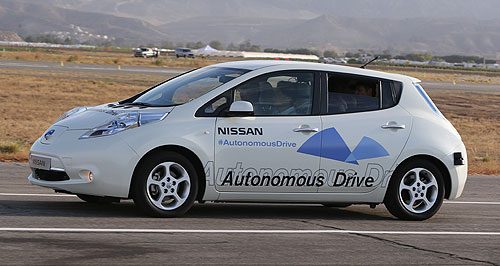News - NissanNissan maps out self-steering future – with a driverDriver assistance: Nissan has confirmed a number of technologies it will roll out in the coming years, using autonomous driving technology. Drivers will still be a key part of Nissan’s autonomous car, company says18 Jul 2014 By BARRY PARK WHEN is a self-driving car not a self-driving car? When it wears a Nissan badge on the front, according to the Japanese car-maker’s global chief executive. Nissan chief executive Carlos Ghosn overnight laid bare the company’s plans to have an autonomous car in showrooms by 2020, with the technology likely to be locked in place by 2018, but in an important distinction from concepts such as Google’s pilot-free pods, with an attentive driver behind the wheel. “Autonomous drive technologies, which are being introduced progressively by Nissan, are designed to enhance road safety and driving conditions by automating everyday tasks for motorists,” the car-maker said in a release mapping out its plans for technology that includes the ability to safely cross intersections. “Unlike pilot projects for completely self-driving vehicles, currently undergoing preliminary tests elsewhere in the industry, drivers remain in control and `at the wheel' in Nissan models equipped with autonomous drive functions,” it said. According to Mr Ghosn, future Nissan models will add automated lane controls and highway traffic management systems over the next four years as an introduction to autonomous drive systems. "By the end of 2016, Nissan will make available the next two technologies under its autonomous drive strategy," Mr Ghosn said. "We are bringing to market a traffic-jam pilot, a technology enabling cars to drive autonomously – and safely – on congested highways. “In the same timeframe, we will make fully-automated parking systems available across a wide range of vehicles."In about 2018, Nissan said it would add multiple-lane controls, allowing cars to autonomously steer around hazards, and even change lanes. Nissan said it was also aiming to change the way owners connected with their cars, with demand growing for in-car communications that “meet or exceed the high expectations of the digital generation”. “Our vehicles must be as connected as the smartphones and tablets that this generation depends upon day in and day out,” Mr Ghosn said. As well, Nissan will aim development at a growing number of elderly drivers expected to make up a larger proportion of road users in the future. “These consumers want technologies and automated systems that enable them to drive safely, for longer,” he said. Another challenge for Nissan, he said, was to bridge the gender gap when it came to buying a car. “This means recognising the vital role that women play as consumer-purchasers, decision-makers and managers throughout the car industry," he said. Nissan’s announcement about its need to change in response to future car owners’ demands comes at the same time as a German research group says it expects car-sharing to grow to 35 percent of the market by 2020. The Roland Berger study, titled “Shared Mobility: How new businesses are rewriting the rules of the private transportation game”, says younger generations are becoming more familiar with the concept of using a product rather than owning it.  Read more8th of July 2014  Mercedes tests autonomous Future Truck 2025Highway Pilot will turn driver into transport manager inside 10 years says Mercedes28th of May 2014  Google shows off bubble of the futureSelf-driving car revealed by Google as it steps up tests of autonomous driving |
Click to shareNissan articlesResearch Nissan Motor industry news |
















Facebook Twitter Instagram